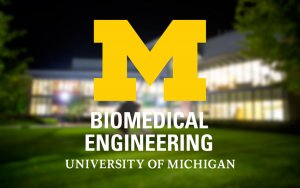Presented By: Biomedical Engineering
Ph.D. Defense: Kunal Rambhia
"Simultaneous Delivery of FGF-2 and BMP-7 Enhances Bone Regeneration on Novel Biomimetic Scaffolds"

The purpose of this dissertation is to advance the development of a drug-loaded polymeric scaffold for bone tissue engineering as a promising synthetic substitute for autologous bone grafts. While still considered the reference standard for treatment of large volume bone injuries, autologous grafts are limited in their clinical applications by donor site morbidity, limited tissue availability, and potential for graft failure. The clinical use of bone morphogenetic proteins (BMP) as bone graft substitutes has resulted in serious side effects due in part to the supraphysiologic dose of BMP required for adequate healing. New approaches to treating these large volume injuries are needed. Our proposed strategy utilizes tissue engineering and drug delivery concepts to develop synthetic drug-loaded biomimetic scaffolds for bone regeneration.
To enhance the osteogenic potential of synthetic scaffolds, we sought to simultaneously deliver two growth factors: recombinant human BMP-7 and recombinant human basic fibroblast growth factor (FGF-2). We first established an in vitro cell culture model using rabbit mesenchymal stem cells to evaluate and optimize the dose and duration of FGF-2 treatment in combination with BMP-7 as a basis for our in vivo studies. We subsequently encapsulated the growth factors in poly (lactic-co-glycolic acid) (PLGA) nanospheres with tailored release patterns for each factor. Low molecular weight PLGA was used to encapsulate FGF-2 in fast releasing nanospheres while high molecular weight PLGA was used to encapsulate BMP-7 in slow releasing nanospheres. We found that FGF-2 augmented BMP-7-directed ectopic bone formation in a subcutaneous mouse model, and that the synergistic effect was dependent on the dose and duration of FGF-2 treatment. We also found that FGF-2 may contribute to enhanced bone formation due to its effects on cell migration and proliferation, as well as its angiogenic and osteogenic effects.
We then established an in vitro model to evaluate human mesenchymal stem cells in 2D monolayer and 3D culture on novel nanofibrous spongy microsphere scaffold (NF-SMS). We used a similar PLGA-based drug delivery system to control the release kinetics of FGF-2 and BMP-7 and conjugated drug-loaded PLGA nanospheres to the injectable NF-SMS scaffold. In a critical size cranial defect mouse model, low dose FGF-2 combined with BMP-7 enhanced bone regeneration over BMP-7 alone.
Lastly, we sought to better understand the crosstalk between the FGF-2 and BMP-7 signaling pathways through a series of experiments to measure the effect of FGF-2 on canonical BMP signaling in mouse calvarial osteoblasts. We identified a potential new link between these signaling pathways and propose a new mechanism by which FGF-2 signaling modulates BMP receptor activity, enhancing the phosphorylation of R-Smad1/5/9 proteins.
This research elucidates the criteria for achieving synergy between BMP-7 and FGF-2 through relevant in vitro and in vivo models. It provides guidelines for future development of biomimetic scaffolds with controlled release of multiple relevant biological cues to stimulate healing and tissue regeneration.
Chair: Peter X. Ma
To enhance the osteogenic potential of synthetic scaffolds, we sought to simultaneously deliver two growth factors: recombinant human BMP-7 and recombinant human basic fibroblast growth factor (FGF-2). We first established an in vitro cell culture model using rabbit mesenchymal stem cells to evaluate and optimize the dose and duration of FGF-2 treatment in combination with BMP-7 as a basis for our in vivo studies. We subsequently encapsulated the growth factors in poly (lactic-co-glycolic acid) (PLGA) nanospheres with tailored release patterns for each factor. Low molecular weight PLGA was used to encapsulate FGF-2 in fast releasing nanospheres while high molecular weight PLGA was used to encapsulate BMP-7 in slow releasing nanospheres. We found that FGF-2 augmented BMP-7-directed ectopic bone formation in a subcutaneous mouse model, and that the synergistic effect was dependent on the dose and duration of FGF-2 treatment. We also found that FGF-2 may contribute to enhanced bone formation due to its effects on cell migration and proliferation, as well as its angiogenic and osteogenic effects.
We then established an in vitro model to evaluate human mesenchymal stem cells in 2D monolayer and 3D culture on novel nanofibrous spongy microsphere scaffold (NF-SMS). We used a similar PLGA-based drug delivery system to control the release kinetics of FGF-2 and BMP-7 and conjugated drug-loaded PLGA nanospheres to the injectable NF-SMS scaffold. In a critical size cranial defect mouse model, low dose FGF-2 combined with BMP-7 enhanced bone regeneration over BMP-7 alone.
Lastly, we sought to better understand the crosstalk between the FGF-2 and BMP-7 signaling pathways through a series of experiments to measure the effect of FGF-2 on canonical BMP signaling in mouse calvarial osteoblasts. We identified a potential new link between these signaling pathways and propose a new mechanism by which FGF-2 signaling modulates BMP receptor activity, enhancing the phosphorylation of R-Smad1/5/9 proteins.
This research elucidates the criteria for achieving synergy between BMP-7 and FGF-2 through relevant in vitro and in vivo models. It provides guidelines for future development of biomimetic scaffolds with controlled release of multiple relevant biological cues to stimulate healing and tissue regeneration.
Chair: Peter X. Ma